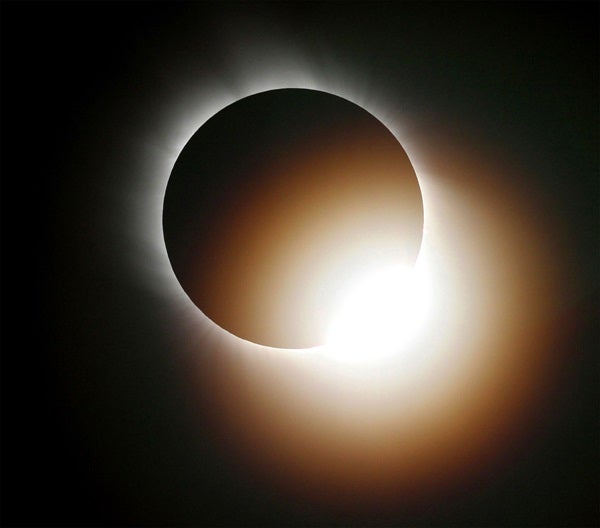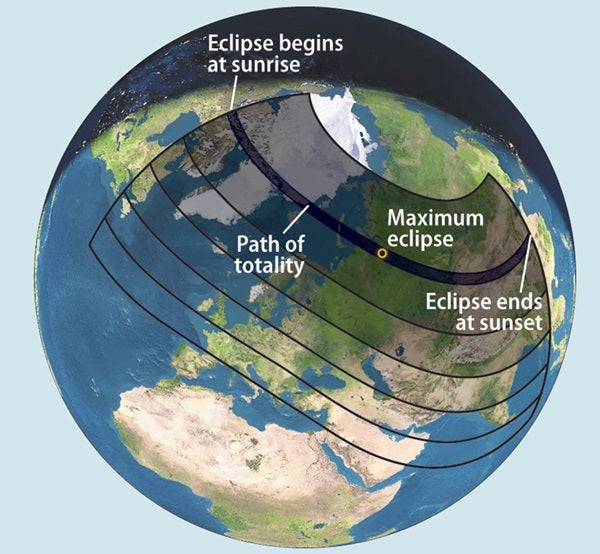On Friday, August 1, 2008, a celestial lineup will turn daytime into dusk during the 21st century’s sixth total solar eclipse. As the Moon slowly covers the Sun’s face — then hides it for as long as 2.5 minutes — where you are will determine how much of this event you’ll see.
This total eclipse is visible from within a narrow corridor that traverses half the Earth. The path of the Moon’s umbral shadow — the dark, inner part where the eclipse is total — begins in Canada and extends across northern Greenland, the Arctic, central Russia, Mongolia, and China. Inhabitants of those regions outside the central eclipse path will see a partial eclipse if they fall under the much broader path of the Moon’s penumbral shadow — the outer, lighter part. The partial eclipse zone includes northeastern North America and most of Europe and Asia. Unfortunately, none of the United States falls under any part of the Moon’s shadow.
A total solar eclipse occurs when the Sun, the Moon, and Earth align, with the Moon in the middle. In a rough sense, this happens every 29.5 days, each time there’s a New Moon. The Moon’s orbit tilts about 5° to Earth’s orbit, so most of the time the Moon lies above or below the center line of the three bodies. Only when it lies on that line does totality occur, and then only for a narrow path where the inner (darkest) part of the Moon’s shadow touches Earth.
Regions that fall under the outer portion of the Moon’s shadow experience a partial eclipse. The closer a location is to the center line, the deeper (percentage-wise) the eclipse.
August’s eclipse arcs across more than 6,200 miles (10,000 km) of Earth’s surface. Unfortunately, most of this path either lies in regions difficult to reach or in areas likely to be cloudy. Still, many amateur astronomers and eclipse lovers will travel thousands of miles to see this event. Two locations offer good accessibility — and a better than 50 percent chance of clear skies.
The first location, Novosibirsk, Russia, marks the destination of many tour groups. The second destination is Hami, China. The eclipse’s center line (where the event’s length is greatest) passes a bit west of Novosibirsk, directly over its airport near the town of Ob, which has a population of some 25,000.
Novosibirsk sits in Siberia in central Russia, but forecasters expect no frigid conditions August 1. Both satellite data and surface observations show a 54-percent likelihood of sunshine there. This city has another advantage in terms of getting there: With a population of 2.7 million, it ranks as Russia’s third-largest metropolis.
Another good spot for eclipse watchers will be northern China, just past the Altai Mountains on the Russia-China border. Rainfall is uncommon because the mountains block much of the weather patterns moving through this region and because the eclipse path passes between the Taklimakan and Gobi deserts.
Eclipse tour leader Jackie Beucher from Kansas City says: “There’s nothing like a total eclipse. No experience you’ll ever have compares to standing under the Moon’s shadow in the daytime, seeing planets and bright stars, not to mention the Sun’s corona.”
Altitude: the distance, in degrees, above the horizon; measured from 0° (the horizon) to 90° (the zenith).
Center line: the midpoint of the Moon’s shadow path width, where the eclipse lasts longest.
Chromosphere: a thin layer of the Sun’s atmosphere just above the visible photosphere; visible briefly as a flash of red as totality begins and ends.
Corona: the Sun’s tenuous outer atmosphere, visible only during totality.
First contact: the moment the partial eclipse begins.
Fourth contact: the moment the partial eclipse ends.
Penumbra: the lighter outer part of the Moon’s shadow where you experience a partial eclipse.
Second contact: the moment the total eclipse begins.
Third contact: the moment the total eclipse ends.
Umbra: the dark inner part of the Moon’s shadow, where you experience totality.
• The eclipse begins in Canada, touches parts of Greenland, Russia, Kazakhstan, and Mongolia, and ends in China.
• The shadow will reach its most northerly latitude, 83°47′, at 9h38m UT in the Arctic Ocean.
• The instant of greatest eclipse occurs at 10h21m07s UT at latitude 65°39′ north.
• The shadow attains a maximum width of 147 miles (237 km).
• The total shadow path is 6,325 miles (10,200 km) long.
• During the eclipse, the Moon’s shadow covers 0.4 percent of Earth’s surface.
• The entire eclipse lasts 2 hours, 3 minutes (totality lasts a maximum of 2 minutes, 27 seconds).











